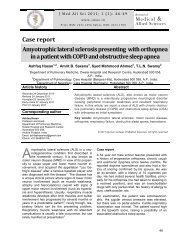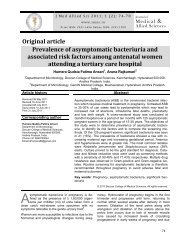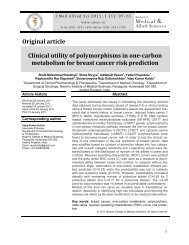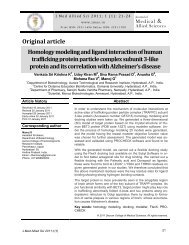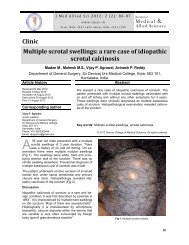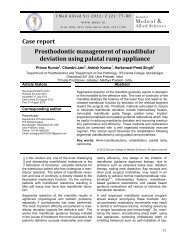Free radicals, oxidative stress and importance of antioxidants in ...
Free radicals, oxidative stress and importance of antioxidants in ...
Free radicals, oxidative stress and importance of antioxidants in ...
Create successful ePaper yourself
Turn your PDF publications into a flip-book with our unique Google optimized e-Paper software.
Kunwar A et al. <strong>Free</strong> <strong>radicals</strong>, <strong>oxidative</strong> <strong>stress</strong> <strong>and</strong> <strong>antioxidants</strong> <strong>in</strong> human health<br />
<strong>in</strong>e <strong>and</strong> methion<strong>in</strong>e residues are susceptible to oxidation<br />
by ROS. Prote<strong>in</strong> oxidation products are usually<br />
carbonyls such as aldehydes <strong>and</strong> ketones.<br />
Although DNA is a stable, well-protected molecule,<br />
ROS can <strong>in</strong>teract with it <strong>and</strong> cause several types <strong>of</strong><br />
damage such as modification <strong>of</strong> DNA bases, s<strong>in</strong>gle<br />
<strong>and</strong> double str<strong>and</strong> DNA breaks, loss <strong>of</strong> pur<strong>in</strong>es (apur<strong>in</strong>ic<br />
sites), damage to the deoxyribose sugar, DNAprote<strong>in</strong><br />
cross-l<strong>in</strong>kage <strong>and</strong> damage to the DNA repair<br />
system 5 . Not all ROS can cause DNA damage <strong>and</strong><br />
OH radical is one <strong>of</strong> the potential <strong>in</strong>ducers <strong>of</strong> DNA<br />
damage. A variety <strong>of</strong> adducts are formed on reaction<br />
<strong>of</strong> OH radical with DNA. The OH radical can attack<br />
pur<strong>in</strong>e <strong>and</strong> pyrimid<strong>in</strong>e bases to form OH radical adducts,<br />
which are both oxidiz<strong>in</strong>g <strong>and</strong> reduc<strong>in</strong>g <strong>in</strong> nature.<br />
This <strong>in</strong>duces base modifications <strong>and</strong> sometimes<br />
release <strong>of</strong> bases. Some <strong>of</strong> the important base<br />
modifications <strong>in</strong>clude 8-hydroxydeoxyguanos<strong>in</strong>e (8-<br />
OHdG), 8 (or 4-, 5-)-hydroxyaden<strong>in</strong>e, thym<strong>in</strong>e peroxide,<br />
thym<strong>in</strong>e glycols <strong>and</strong> 5-(hydroxymethyl) uracyl 5 .<br />
<strong>Free</strong> <strong>radicals</strong> can also attack the sugar moiety,<br />
which can produce sugar peroxyl <strong>radicals</strong> <strong>and</strong> subsequently<br />
<strong>in</strong>duc<strong>in</strong>g str<strong>and</strong> brakeage. The consequence<br />
<strong>of</strong> DNA damage is the modification <strong>of</strong> genetic<br />
material result<strong>in</strong>g <strong>in</strong> to cell death, mutagenesis,<br />
carc<strong>in</strong>ogenesis <strong>and</strong> age<strong>in</strong>g.<br />
Antioxidants <strong>and</strong> natural defense from ROS <strong>in</strong>duced<br />
damages<br />
Uncontrolled generation <strong>of</strong> ROS can lead to their<br />
accumulation caus<strong>in</strong>g <strong>oxidative</strong> <strong>stress</strong> <strong>in</strong> the cells.<br />
Therefore, cells have evolved defense mechanisms<br />
for protection aga<strong>in</strong>st ROS mediated <strong>oxidative</strong> damage.<br />
These <strong>in</strong>clude antioxidant defenses to keep a<br />
check on the generation <strong>of</strong> ROS. An antioxidant is a<br />
substance that is present at low concentrations <strong>and</strong><br />
significantly delays or prevents oxidation <strong>of</strong> the oxidizable<br />
substrate 6 . Antioxidants are effective because<br />
they can donate their own electrons to ROS<br />
<strong>and</strong> thereby neutraliz<strong>in</strong>g the adverse effects <strong>of</strong> the<br />
latter. In general, an antioxidant <strong>in</strong> the body may<br />
work at three different levels: (a) prevention - keep<strong>in</strong>g<br />
formation <strong>of</strong> reactive species to a m<strong>in</strong>imum e.g.<br />
desferrioxam<strong>in</strong>e (b) <strong>in</strong>terception - scaveng<strong>in</strong>g reactive<br />
species either by us<strong>in</strong>g catalytic <strong>and</strong> noncatalytic<br />
molecules e.g. ascorbic acid, alphatocopherol<br />
<strong>and</strong> (c) repair - repair<strong>in</strong>g damaged target<br />
molecules e.g. glutathione 6 . The antioxidant systems<br />
are classified <strong>in</strong>to two major groups, enzymatic <strong>antioxidants</strong><br />
<strong>and</strong> non enzymatic <strong>antioxidants</strong>. Enzymatic<br />
<strong>antioxidants</strong> present <strong>in</strong> the body <strong>in</strong>clude superoxide<br />
dismutase (SOD), catalase <strong>and</strong> glutathione peroxidase<br />
(GPx) that act as body’s first l<strong>in</strong>e <strong>of</strong> defense<br />
aga<strong>in</strong>st ROS by catalyz<strong>in</strong>g their conversion to less<br />
reactive or <strong>in</strong>ert species (Fig 2) 7 .<br />
J Med Allied Sci 2011; 1(2)<br />
Fig 2. Removal <strong>of</strong> different reactive oxygen species by antioxidant<br />
enzymes<br />
Several low molecular weight molecules present<br />
<strong>in</strong>side the cell provide secondary defense aga<strong>in</strong>st<br />
free <strong>radicals</strong>. A few examples <strong>of</strong> such molecules<br />
<strong>in</strong>clude glutathione (GSH), α-tocopherol, ascorbate,<br />
bilirub<strong>in</strong>, etc 6 . These agents either scavenge the<br />
ROS directly or prevent the production <strong>of</strong> ROS<br />
through sequestration <strong>of</strong> redox active metals like<br />
iron <strong>and</strong> copper.<br />
Redox state <strong>and</strong> <strong>oxidative</strong> <strong>stress</strong><br />
All forms <strong>of</strong> life ma<strong>in</strong>ta<strong>in</strong> a steady state concentration<br />
<strong>of</strong> ROS determ<strong>in</strong>ed by the balance between<br />
their rates <strong>of</strong> production <strong>and</strong> their rates <strong>of</strong> removal<br />
by various <strong>antioxidants</strong>. Thus each cell is characterized<br />
by a particular concentration <strong>of</strong> reduc<strong>in</strong>g species<br />
like GSH, NADH, FADH, etc. stored <strong>in</strong> many<br />
cellular constituents which determ<strong>in</strong>es the redox<br />
state <strong>of</strong> a cell 6 . By def<strong>in</strong>ition redox state is the total<br />
reduction potential or the reduc<strong>in</strong>g capacity <strong>of</strong> all the<br />
redox couples such as GSSG/2GSH, NAD+/NADH,<br />
Asc •− /AcsH − , etc found <strong>in</strong> biological fluids, organelles,<br />
cells or tissues 8 . Redox state not only describes<br />
the state <strong>of</strong> a redox pair, but also the redox<br />
environment <strong>of</strong> a cell. Under normal conditions, the<br />
redox state <strong>of</strong> a biological system is ma<strong>in</strong>ta<strong>in</strong>ed towards<br />
more negative redox potential values. However,<br />
with <strong>in</strong>crease <strong>in</strong> ROS generation or decrease<br />
<strong>in</strong> antioxidant protection with<strong>in</strong> cells, it is shifted towards<br />
less negative values result<strong>in</strong>g <strong>in</strong> the oxidiz<strong>in</strong>g<br />
environment (Fig 3). This shift from reduc<strong>in</strong>g status<br />
to oxidiz<strong>in</strong>g status is referred as <strong>oxidative</strong> <strong>stress</strong> 6,8 .<br />
Dur<strong>in</strong>g elevated <strong>oxidative</strong> <strong>stress</strong>, there is loss <strong>of</strong> mitochondrial<br />
functions, which results <strong>in</strong> to ATP depletion<br />
<strong>and</strong> necrotic cell death, while moderate oxidation<br />
can trigger apoptosis. There are a few recent<br />
reports have shown evidence that the <strong>in</strong>duction <strong>of</strong><br />
apoptosis or necrosis dur<strong>in</strong>g <strong>oxidative</strong> <strong>stress</strong> is actually<br />
determ<strong>in</strong>ed by the redox state <strong>of</strong> cell 8 . For example<br />
it has been reported that an <strong>in</strong>crease <strong>in</strong> reduction<br />
potential <strong>of</strong> +72 mV <strong>in</strong> HL-60 cells (i.e., from<br />
-239 ± 6 to -167 ± 9 mV) or an <strong>in</strong>crease <strong>of</strong> +65 mV<br />
<strong>in</strong> mur<strong>in</strong>e hybridoma cells (i.e., from -235 ± 5 to -170<br />
55



